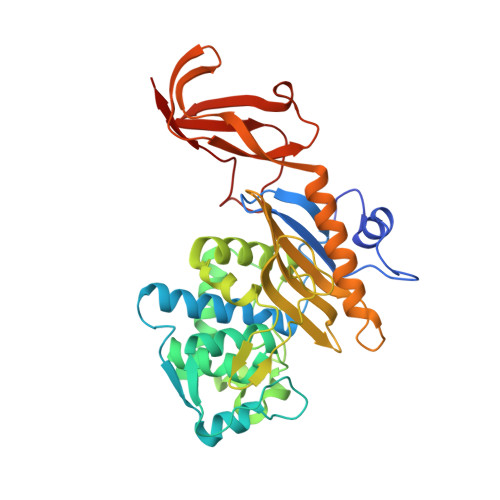PBP4-mediated beta-lactam resistance among clinical strains of Staphylococcus aureus.
Satishkumar, N., Alexander, J.A.N., Poon, R., Buggeln, E., Argudin, M.A., Strynadka, N.C.J., Chatterjee, S.S.(2021) J Antimicrob Chemother 76: 2268-2272
- PubMed: 34151961
- DOI: https://doi.org/10.1093/jac/dkab201
- Primary Citation of Related Structures:
7KCV, 7KCW, 7KCX, 7KCY - PubMed Abstract:
PBP4, a low-molecular-weight PBP in Staphylococcus aureus, is not considered to be a classical mediator of β-lactam resistance. Previous studies carried out by our group with laboratory strains of S. aureus demonstrated the ability of PBP4 to produce β-lactam resistance through mutations associated with the pbp4 promoter and/or gene. Recent studies of β-lactam-resistant clinical isolates of S. aureus have reported similar mutations associated with pbp4. To determine if pbp4-associated mutations reported among clinical strains of S. aureus mediate β-lactam resistance. The pbp4 promoters and genes bearing mutations from clinical isolates were cloned into a heterologous host. Reporter, growth and Bocillin assays were performed to assess their role in β-lactam resistance. X-ray crystallography was used to obtain acyl-enzyme intermediate structures of the WT and mutant PBP4 with nafcillin and cefoxitin. Of the five strains that contained pbp4 promoter mutations, three strains exhibited enhanced expression of PBP4. The R200L mutation in pbp4 resulted in increased survival in the presence of the β-lactams nafcillin and cefoxitin. Further, introduction of either a promoter or a gene mutation into the genome of a WT host increased the ability of the strains to resist the action of β-lactams. The four high-resolution X-ray structures presented demonstrate the binding pose of the β-lactams tested and provide hints for further drug development. Mutations associated with the pbp4 promoter and pbp4 gene altered protein activity and mediated β-lactam resistance among the clinically isolated strains that were studied.
- Department of Microbial Pathogenesis, School of Dentistry, University of Maryland, Baltimore, MD, USA.
Organizational Affiliation:



















